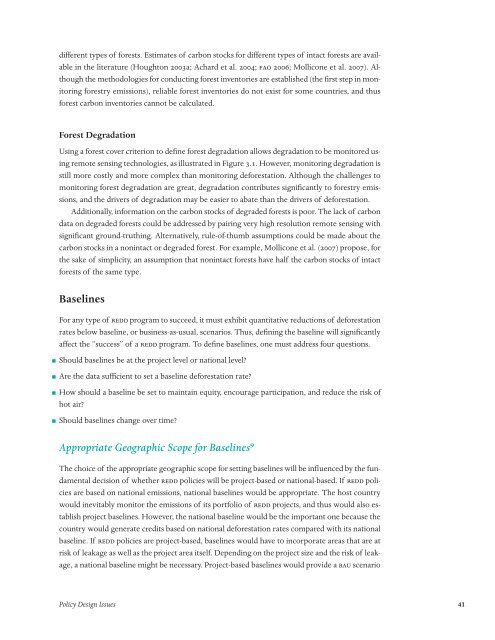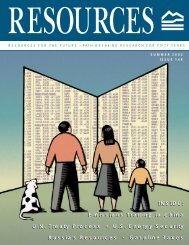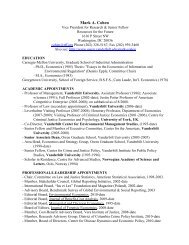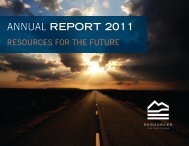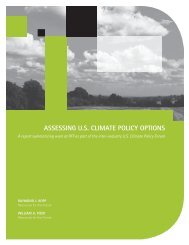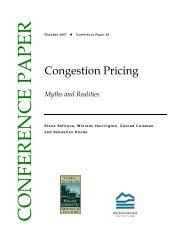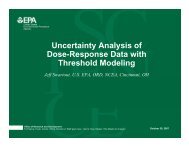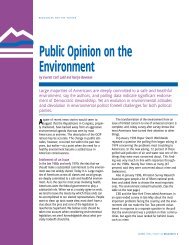Policies to Reduce Emissions from Deforestation and Degradation ...
Policies to Reduce Emissions from Deforestation and Degradation ...
Policies to Reduce Emissions from Deforestation and Degradation ...
Create successful ePaper yourself
Turn your PDF publications into a flip-book with our unique Google optimized e-Paper software.
different types of forests. Estimates of carbon s<strong>to</strong>cks for different types of intact forests are available<br />
in the literature (Hough<strong>to</strong>n 2003a; Achard et al. 2004; FAO 2006; Mollicone et al. 2007). Although<br />
the methodologies for conducting forest inven<strong>to</strong>ries are established (the first step in moni<strong>to</strong>ring<br />
forestry emissions), reliable forest inven<strong>to</strong>ries do not exist for some countries, <strong>and</strong> thus<br />
forest carbon inven<strong>to</strong>ries cannot be calculated.<br />
Forest <strong>Degradation</strong><br />
Using a forest cover criterion <strong>to</strong> define forest degradation allows degradation <strong>to</strong> be moni<strong>to</strong>red using<br />
remote sensing technologies, as illustrated in Figure 3.1. However, moni<strong>to</strong>ring degradation is<br />
still more costly <strong>and</strong> more complex than moni<strong>to</strong>ring deforestation. Although the challenges <strong>to</strong><br />
moni<strong>to</strong>ring forest degradation are great, degradation contributes significantly <strong>to</strong> forestry emissions,<br />
<strong>and</strong> the drivers of degradation may be easier <strong>to</strong> abate than the drivers of deforestation.<br />
Additionally, information on the carbon s<strong>to</strong>cks of degraded forests is poor. The lack of carbon<br />
data on degraded forests could be addressed by pairing very high resolution remote sensing with<br />
significant ground-truthing. Alternatively, rule-of-thumb assumptions could be made about the<br />
carbon s<strong>to</strong>cks in a nonintact or degraded forest. For example, Mollicone et al. (2007) propose, for<br />
the sake of simplicity, an assumption that nonintact forests have half the carbon s<strong>to</strong>cks of intact<br />
forests of the same type.<br />
Baselines<br />
For any type of REDD program <strong>to</strong> succeed, it must exhibit quantitative reductions of deforestation<br />
rates below baseline, or business-as-usual, scenarios. Thus, defining the baseline will significantly<br />
affect the “success” of a REDD program. To define baselines, one must address four questions.<br />
∫ Should baselines be at the project level or national level?<br />
∫ Are the data sufficient <strong>to</strong> set a baseline deforestation rate?<br />
∫ How should a baseline be set <strong>to</strong> maintain equity, encourage participation, <strong>and</strong> reduce the risk of<br />
hot air?<br />
∫ Should baselines change over time?<br />
Appropriate Geographic Scope for Baselines 9<br />
The choice of the appropriate geographic scope for setting baselines will be influenced by the fundamental<br />
decision of whether REDD policies will be project-based or national-based. If REDD policies<br />
are based on national emissions, national baselines would be appropriate. The host country<br />
would inevitably moni<strong>to</strong>r the emissions of its portfolio of REDD projects, <strong>and</strong> thus would also establish<br />
project baselines. However, the national baseline would be the important one because the<br />
country would generate credits based on national deforestation rates compared with its national<br />
baseline. If REDD policies are project-based, baselines would have <strong>to</strong> incorporate areas that are at<br />
risk of leakage as well as the project area itself. Depending on the project size <strong>and</strong> the risk of leakage,<br />
a national baseline might be necessary. Project-based baselines would provide a BAU scenario<br />
Policy Design Issues 41


